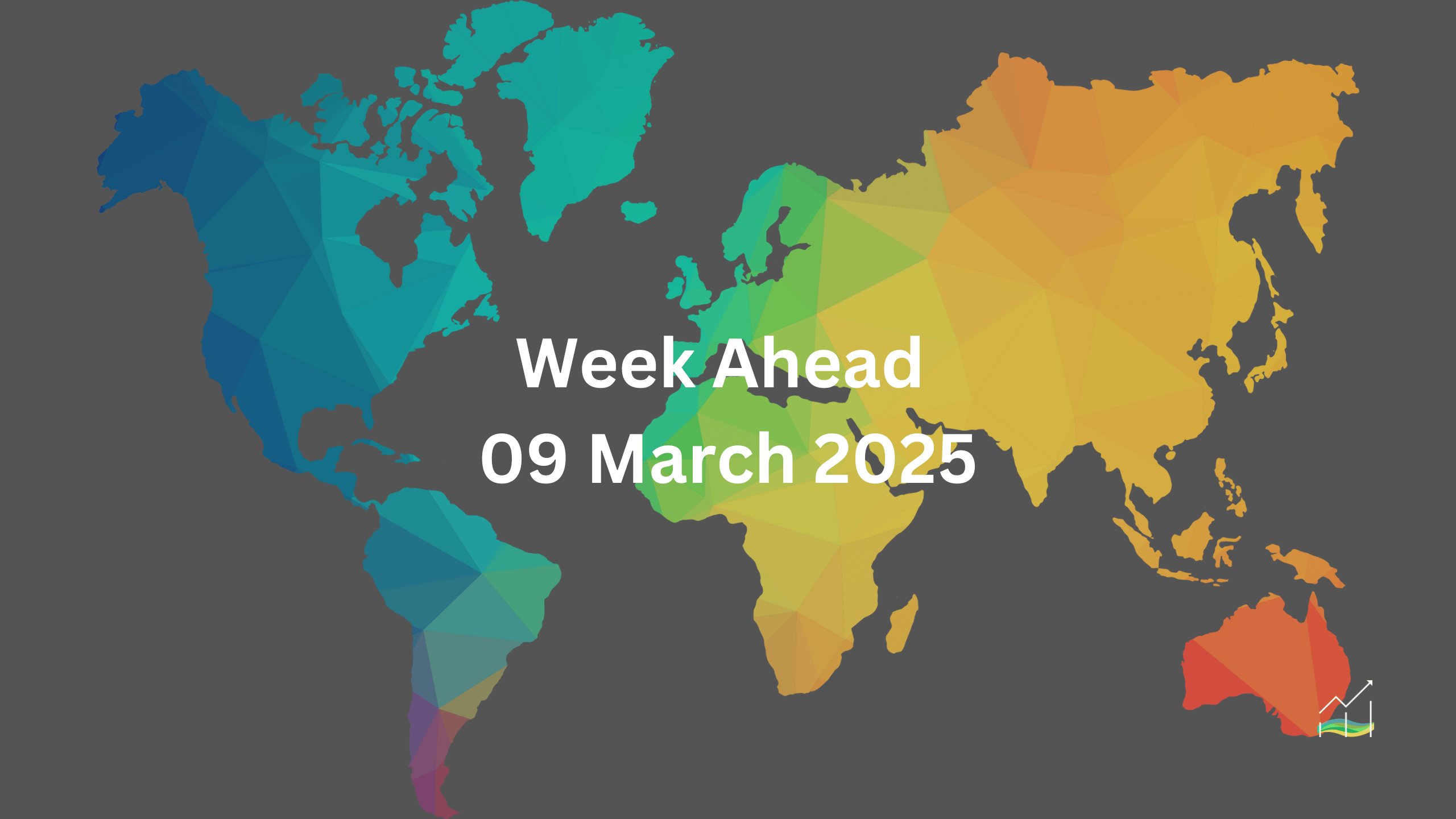09/03/2025 Week Ahead

U.S. Inflation & Global Economic Developments
The upcoming week centers on key economic data, particularly U.S. inflation figures for February. Investors remain attentive to ongoing policy shifts, including tariff-related developments. The Bank of Canada is also set to announce its rate decision, with expectations leaning toward a cut due to economic concerns linked to U.S. tariffs on Canadian imports.
In Asia, markets are watching the conclusion of China’s annual legislative session, alongside multiple data releases from Japan. Meanwhile, global economic uncertainties continue to shape currency and bond market movements.
The U.S. dollar weakened consistently last week as concerns over economic growth persisted. The Atlanta Federal Reserve’s GDP tracker suggests the U.S. economy is contracting at an annualized rate of 2.4%, though this figure may be overstated. After a seven-week decline of about 50 basis points, U.S. 10-year Treasury yields rebounded slightly, rising by approximately 15 basis points. In contrast, Eurozone 10-year yields climbed by around 35 basis points. The narrowing U.S. two-year rate premium also contributed to the dollar’s decline.
Global monetary policy remains a critical factor. The European Central Bank (ECB) recently cut its key rate by 25 basis points, and the Bank of Canada is expected to follow suit. However, markets anticipate the U.S. Federal Reserve will cut rates more aggressively than other central banks this year. Futures pricing suggests two Fed rate cuts are fully factored in, with a 65% probability of a third.
Other key developments include inflation data from both China and the U.S. China’s Consumer Price Index (CPI) may have slipped back into deflation, while U.S. inflation indicators, including CPI and Producer Price Index (PPI), are expected to show slight declines.
Political events may also influence markets. Canada’s Liberal Party is set to select a new leader, with Mark Carney as a leading contender. If elected, he may call for a snap election. In the UK, January GDP figures are expected to show marginal growth of 0.1%. Meanwhile, EU finance ministers will meet early in the week to discuss fiscal policy initiatives.
These developments will shape global markets, with investors closely monitoring inflation trends, central bank policies, and geopolitical shifts.
United States of America
Overview
The upcoming U.S. inflation data for February is the key economic event this week, with markets closely watching its potential impact on Federal Reserve policy. Concerns over tariffs and economic uncertainty continue to weigh on sentiment, while the Federal Reserve faces growing pressure to cut interest rates. Other notable events include the University of Michigan consumer survey, U.S. Treasury auctions, and key producer price data. Meanwhile, U.S. interest rate trends and policy shifts in Europe have triggered fluctuations in global markets.
Economic Drivers
Several factors are influencing market sentiment and economic expectations:
- Inflation & Tariffs: Business surveys indicate that companies are preemptively raising prices due to anticipated tariffs. Rising food and energy costs are also contributing to inflationary pressures.
- Federal Reserve Rate Outlook: Markets are now pricing in three 25 basis-point rate cuts in 2024, up from just one a few weeks ago.
- Tariff Implications: The U.S. is set to impose a 25% tariff on steel and aluminum imports from the EU, potentially extending to copper. This could drive further inflation and supply chain disruptions.
- Government Debt & Shutdown Risks: The U.S. debt ceiling will be reached on March 15, raising concerns about a possible government shutdown.
- Global Market Reaction: Fiscal developments in Europe have pushed interest rates higher, narrowing the U.S. interest rate premium and adding to volatility in global markets.
Data and Events
Several key reports and events will shape market expectations:
- U.S. Inflation Data (Wednesday, March 13) – February CPI figures will be released, with expectations of slight declines in year-over-year inflation rates (2.9% headline, 3.2% core).
- Producer Price Index (PPI) (Thursday, March 14) – Expected to show slowing inflation trends, with the headline rate forecasted at 3.2% and core rate steady at 3.6%.
- University of Michigan Consumer Survey (Friday, March 15) – Will provide insight into consumer sentiment amid inflation and policy uncertainty.
- U.S. Treasury Auctions – The government will issue three-year notes ($58 billion on Tuesday), 10-year notes ($39 billion on Wednesday), and 30-year bonds ($22 billion on Thursday).
- Other Reports – The federal budget deficit for February stood at approximately $296 billion, while Q4 household net worth data is expected to highlight overall financial strength in the U.S. economy.
Price Action
The U.S. dollar weakened significantly last week as concerns over economic growth and narrowing interest rate differentials drove declines. The Dollar Index (DXY) fell sharply, breaking below key technical levels near 104. Chart indicators suggest further downside pressure, with support near 102. A rebound above 104.40 would be needed to stabilize the trend.
Key Points:
- U.S. inflation data for February is expected to show a modest decline, but tariff-related price increases remain a risk.
- Markets are pricing in three Federal Reserve rate cuts this year, reflecting concerns about economic growth.
- The U.S. will impose tariffs on steel and aluminum from the EU, with possible extensions to copper.
- A government shutdown remains a possibility as the U.S. debt ceiling deadline approaches.
- The U.S. dollar weakened as interest rate differentials narrowed, with further declines possible unless momentum shifts.
Australia
Overview
Australia's economic outlook remains in focus, with government spending playing a key role in sustaining growth as private demand struggles to recover. The upcoming National Australia Bank (NAB) business survey may provide insights into whether private sector confidence is improving. Meanwhile, global trade tensions and shifting defense policies continue to influence currency movements, particularly for the Australian and New Zealand dollars.
Economic Drivers
Several factors are shaping market sentiment and economic expectations:
- Government Spending vs. Private Demand: Public sector investment has been a key support for growth, but a shift toward private demand is necessary to sustain momentum.
- Trade War Concerns: Uncertainty over U.S. trade policies has pressured the Australian and New Zealand dollars, although recent European defense initiatives have provided some relief.
- Currency Correlations: The Australian dollar maintains a strong correlation with the Canadian dollar (0.78), while showing an inverse relationship (-0.55) with the U.S. Dollar Index.
- Central Bank Outlook: The Reserve Bank of Australia (RBA) is not expected to make policy changes until its next meeting on April 1, leaving markets focused on upcoming data releases.
Data and Events
Key reports and economic events in the coming weeks include:
- NAB Business Survey (Tuesday, March 12) – Will offer insights into business confidence and private sector demand.
- Labor Market Report (Wednesday, March 20) – A crucial indicator of employment trends that could impact policy expectations.
- February CPI (Tuesday, March 26) – Inflation data will be closely watched for signals on consumer price pressures and potential monetary policy shifts.
Price Action
The Australian dollar showed resilience last week, rebounding from a dip below $0.6200 to reach nearly $0.6365 before pulling back to $0.6280. Despite the recovery, momentum indicators remain mixed, with the currency trading within a well-established range of $0.6200 to $0.6400. Market movements in the coming weeks will likely be influenced by domestic economic data and global risk sentiment.
Key Points:
- Australia's economic stability has been supported by government spending, but private demand recovery is essential for sustained growth.
- The NAB business survey will provide insights into business confidence and economic momentum.
- Trade war concerns initially pressured the Australian dollar, but recent developments helped it recover.
- The Australian dollar remains within a defined range, with key support at $0.6200 and resistance near $0.6400.
- Upcoming labor market and inflation data will be critical in shaping expectations for the Reserve Bank of Australia’s next policy decision.
Canada
Overview
Canada remains in focus as tariff threats from the U.S. and economic concerns grow. The Bank of Canada (BoC) is set to announce its interest rate decision, with markets heavily pricing in a rate cut amid weak job data and trade uncertainty. Meanwhile, political developments could add further volatility, as the country prepares for a new Liberal Party leader who may push for a snap election.
Economic Drivers
Several key factors are shaping Canada’s economic outlook and financial markets:
- U.S. Tariff Threats: The U.S. continues to pressure Canada with tariff threats on dairy and lumber, adding to economic uncertainty.
- Weak Employment Data: Canada’s economy added just 1.1K jobs in February, while full-time employment fell by nearly 20K. The unemployment rate climbed to 6.6% from 5.9% a month earlier.
- Rate Cut Expectations: Money markets now price in an 85% chance of a BoC rate cut, up from 50% just a week ago, as economic conditions weaken.
- Political Uncertainty: Former BoC and Bank of England Governor Mark Carney is expected to win the Liberal Party leadership, raising speculation of a snap election.
Data and Events
Key economic releases and events to watch this week:
- Bank of Canada Interest Rate Decision (Wednesday, March 12) – A rate cut is widely expected as the economy slows.
- Liberal Party Leadership Contest (Monday, March 11) – Carney is likely to win, with a potential early election on the horizon.
- U.S.-Canada Trade Developments – Ongoing discussions and tariff decisions may impact Canadian exports and economic sentiment.
Price Action
The Canadian dollar struggled last week, posting the smallest gain among G10 currencies. It briefly strengthened to CAD1.4240 per U.S. dollar before retreating under renewed tariff threats. The U.S. dollar recovered to CAD1.4425 but pulled back to around CAD1.4365. A sustained close above CAD1.4400 could signal a move toward last week’s high of CAD1.4550, a key technical resistance level.
Key Points:
- Canada faces mounting pressure from U.S. tariffs, with threats extending to dairy and lumber.
- Weak job data supports expectations of a Bank of Canada rate cut, with markets pricing in an 85% probability.
- Mark Carney is expected to lead Canada’s Liberal Party, raising the possibility of a snap election.
- The Canadian dollar remains under pressure, with key technical levels near CAD1.4400 and CAD1.4550 in focus.
- Investors will closely watch Wednesday’s BoC decision and any new trade developments between Canada and the U.S.
China
Overview
China’s annual legislative session is set to conclude, with lawmakers expected to approve a 2025 growth target of around 5%. Markets are watching for concrete policy actions to follow recent stimulus pledges aimed at boosting fiscal spending and consumption. Meanwhile, economic data releases, including credit growth and inflation figures, will provide further insights into the country’s financial health.
Economic Drivers
Several factors are influencing China’s economic landscape and financial markets:
- Growth Target: The government is aiming for around 5% growth in 2025, signaling a strong economic recovery plan.
- Stimulus Measures: Authorities have announced plans to increase fiscal spending and encourage domestic consumption.
- Credit Growth Trends: Banks issued an estimated 1.23 trillion yuan in new loans in February, significantly lower than January’s 5.13 trillion yuan, mainly due to seasonal factors.
- Monetary Supply: M2 money supply is expected to have grown by 7% year-over-year in February, maintaining the same pace as January.
- Tariff Impact: The U.S. has imposed a 10% tariff on Chinese imports, including goods from Hong Kong, which could contribute to inflationary pressures in the U.S. and trade disruptions.
Data and Events
Key reports and economic events to watch this week:
- China’s CPI and PPI Data (March 11-15) – February inflation figures will indicate consumer and producer price trends, with PPI deflation expected to moderate.
- Credit and Lending Data (March 11-15) – China’s central bank is likely to release data on credit growth, offering insights into borrowing trends and liquidity conditions.
- Foreign Direct Investment Figures (March 11-15) – Data on capital inflows will be closely watched as China looks to attract more international investment.
Price Action
The offshore yuan strengthened against the U.S. dollar last week, marking its biggest gain in six weeks at 0.66%. The dollar fell to CNH7.2280, nearing last month’s low of CNH7.2260 and the key 200-day moving average at CNH7.2220. The yuan has not traded below this level since November 8. Meanwhile, the People’s Bank of China (PBOC) has kept the official exchange rate stable between CNY7.1691 and CNY7.1745 since late January. Year-to-date, the offshore yuan has appreciated by approximately 1.4%.
Key Points:
- China is targeting around 5% growth for 2025, with a focus on fiscal spending and consumption.
- U.S. tariffs on Chinese imports, including goods from Hong Kong, could impact trade and inflation.
- February credit growth is expected to be significantly lower than January’s due to seasonal factors.
- Inflation data will be key in assessing price trends, with PPI deflation expected to ease slightly.
- The offshore yuan strengthened last week, with technical levels indicating potential resistance near CNH7.2220.
Europe
Overview
A relatively quiet economic calendar this week keeps investors focused on Germany’s large-scale fiscal stimulus and planned defense spending increases. The impact of these policies on European growth, inflation, and European Central Bank (ECB) rate decisions remains a key concern. Market expectations for further ECB rate cuts have shifted, with major financial institutions scaling back their forecasts. Meanwhile, government bond auctions and industrial production data will provide further insight into economic conditions.
Economic Drivers
Several factors are influencing Europe’s financial markets and policy decisions:
- Germany’s Fiscal Stimulus: A €500 billion package (11.4% of GDP over the next decade) is set to boost growth, impacting inflation and monetary policy.
- Defense Spending and Fiscal Policy: A more relaxed European Commission stance on budget deficits related to defense spending could reshape fiscal policy across the eurozone.
- ECB Rate Expectations: Following last week’s 25-basis-point rate cut, Vanguard now expects just one more cut this year, while AllianceBernstein sees a higher policy rate of 2% by the end of 2025.
- U.S. Tariff Threats and Global Relations: The U.S. siding with Russia at the UN has broader geopolitical implications, influencing European interest rate trends and market sentiment.
Data and Events
Key economic reports and financial events to monitor:
- Germany’s Industrial Production (Monday, March 11) – Provides insight into the country’s manufacturing output and economic activity.
- Eurozone Industrial Production (Thursday, March 14) – A broader indicator of the region’s economic health.
- Final Inflation Data (Friday, March 15) – France and Spain’s February inflation figures will clarify price trends across the eurozone.
- EU Finance Ministers Meeting (Monday and Tuesday, March 11-12) – Discussions on the new fiscal stance and potential joint bond issuance.
- Government Bond Auctions:
- Germany (Tuesday, March 12) – €4.5 billion in March 2027 Schatz bonds.
- Germany (Wednesday, March 13) – €4.5 billion in February 2035 Bund bonds.
- Portugal (Wednesday, March 13) and Italy (Thursday, March 14) – Additional auctions providing insights into debt markets.
Price Action
The euro posted its best weekly performance since 1990, reaching nearly $1.0890, its highest level since early November. The euro remains technically strong, having settled above its upper Bollinger Band (~$1.0795) for four consecutive sessions. A move above $1.0940 could open the door to testing the $1.10 level, while initial support lies near $1.08 and $1.0765. Meanwhile, U.S. and European interest rate spreads continue to narrow, with the U.S. two-year premium over Germany declining for the fourth straight week, now at its lowest level in five months.
Key Points:
- Germany’s €500 billion fiscal stimulus is expected to drive economic growth but may contribute to inflation.
- The ECB’s rate outlook has shifted, with fewer cuts expected this year as markets adjust to fiscal expansion.
- Germany, Portugal, and Italy will hold government bond auctions, providing key insights into investor sentiment.
- The euro had its strongest weekly gain in decades, with technical levels suggesting further upside potential.
- EU finance ministers will discuss fiscal policy adjustments, potentially influencing debt issuance strategies.
Japan
Overview
Japan’s economy is under close watch this week, with key data releases and wage negotiations shaping market expectations. The Japanese Trade Union Confederation (Rengo) will announce preliminary wage hike results, with unions seeking the largest increase in three decades. Meanwhile, GDP revisions are expected to confirm continued economic expansion, while household spending data could indicate a recovery in private consumption. The Bank of Japan (BOJ) remains focused on wage growth and inflation as it considers its policy stance, while financial markets track movements in bond yields and currency valuations.
Economic Drivers
Several factors are influencing Japan’s economic trajectory and financial markets:
- Wage Negotiations: Rengo is pushing for a 6.09% wage increase, the highest in 30 years, which could impact BOJ policy decisions.
- Economic Growth: Japan’s economy likely expanded for a third straight quarter, with GDP expected to confirm a 2.8% annualized growth rate for Q4 2024.
- Household Spending Trends: January spending is projected to rise by 3.5% year-over-year, signaling a potential rebound in consumer demand.
- BOJ Policy Outlook: The central bank is closely monitoring labor earnings and inflation before making any policy adjustments.
- Bond Market Movements: The yield on 10-year Japanese government bonds (JGBs) climbed above 1.5% for the first time since 2009, while the U.S. 10-year premium over Japan narrowed significantly.
Data and Events
Key reports and financial events to monitor:
- January Labor Earnings (Monday, March 11) – A critical metric for BOJ policy considerations.
- January Trade and Current Account Balance (Monday, March 11) – Expected to show a seasonal deterioration before improving in February.
- Revised GDP Data (Tuesday, March 12) – Likely to confirm 2.8% growth in Q4 2024.
- Household Spending Data (Tuesday, March 12) – An increase of 3.5% is expected, indicating stronger private consumption.
- Wage Negotiation Results (Friday, March 14) – Rengo’s announcement on wage hikes could influence BOJ policy decisions.
- Government Bond Auctions:
- Five-Year JGBs (Monday, March 11) – ¥2.3 trillion issuance.
- 20-Year JGBs (Wednesday, March 13) – ¥1 trillion issuance, expected to attract demand from pension funds and insurance firms due to higher yields.
Price Action
The U.S. dollar weakened against the yen last week, briefly touching JPY147.00 before rebounding above JPY148. The correlation between the 10-year U.S. Treasury yield and the dollar-yen exchange rate has weakened, falling from 0.70 in mid-January to 0.50. The swaps market indicates an 80% chance of a BOJ rate hike in July, with full pricing by September. Meanwhile, the U.S. 10-year premium over Japan narrowed to 271 basis points, the lowest since August 2022, after previously exceeding 350 basis points two months ago.
Key Points:
- Japan’s largest trade union is pushing for a 6.09% wage increase, which could influence BOJ policy.
- Revised GDP data is expected to confirm 2.8% growth for Q4 2024.
- Household spending may have increased 3.5% in January, supporting a consumption recovery.
- The BOJ is closely monitoring labor earnings and inflation before adjusting its monetary stance.
- U.S.-Japan yield spreads continue to narrow, with the U.S. 10-year premium over Japan at its lowest level since 2022.
- The dollar-yen exchange rate remains volatile, with key support at JPY147.00 and resistance near JPY148.50.
Switzerland
Switzerland will hold a bond auction on Wednesday.
United Kingdom
Overview
The UK’s January GDP data is set for release, following a stronger-than-expected performance in December. While growth momentum may continue in the short term, uncertainties remain. Meanwhile, the government is preparing to issue new long-term gilts, and market sentiment is adjusting to expectations around Bank of England (BOE) rate cuts. The pound has rallied in recent weeks, supported by broader market dynamics and shifts in interest rate expectations.
Economic Drivers
Several factors are influencing the UK economy and financial markets:
- GDP Growth Outlook: December’s strong GDP performance suggests some momentum, but forecasts indicate a modest 0.2% increase for January, with slower growth expected throughout the year.
- Monetary Policy Expectations: The BOE is not expected to cut rates in its March 20 meeting, but markets are pricing in an 80% chance of a cut on May 8.
- Government Bond Issuance: The UK plans to issue a new September 2049 index-linked gilt in the coming week, alongside the scheduled sale of March 2035 gilts.
- Global Trade and Political Developments: Brexit-related opportunities and Europe's evolving defense needs could influence future UK-EU cooperation, while U.S. trade policy remains a wildcard.
Data and Events
Key economic reports and financial events to monitor:
- UK January GDP Report (Friday, March 14) – A 0.2% month-on-month expansion is expected, though growth could slow later in the year.
- UK Gilt Issuance (Week of March 10) – A new 2049 index-linked gilt is planned, depending on market demand.
- UK Gilt Auction (Wednesday, March 13) – The sale of March 2035 gilts will provide insights into investor sentiment.
- BOE Rate Decision (March 20) – While no change is expected, markets anticipate a potential rate cut in May.
Price Action
Sterling posted its biggest weekly gain since November 2022, rising by 2.65% and reaching $1.2945 before the latest U.S. employment data. It has now gained in four of the past five weeks. The pound is testing resistance near $1.2930, with the next major resistance level at $1.3000–$1.3050. Momentum indicators suggest the currency is stretched, and a break below $1.2850 could signal an impending correction.
Key Points:
- UK GDP for January is expected to show 0.2% growth, but future momentum remains uncertain.
- The BOE is unlikely to cut rates in March, but markets are pricing in an 80% chance of a cut in May.
- The UK government plans to issue a new 2049 index-linked gilt and auction 2035 gilts this week.
- Sterling has rallied strongly, reaching its highest level in months, with resistance near $1.3000–$1.3050.
- A break below $1.2850 could indicate a downside correction in the currency’s recent upward trend.
© 2025 SKONE Enterprise (003319453-V). All rights reserved.
The content on this site is for informational purposes only and does not constitute financial advice.


